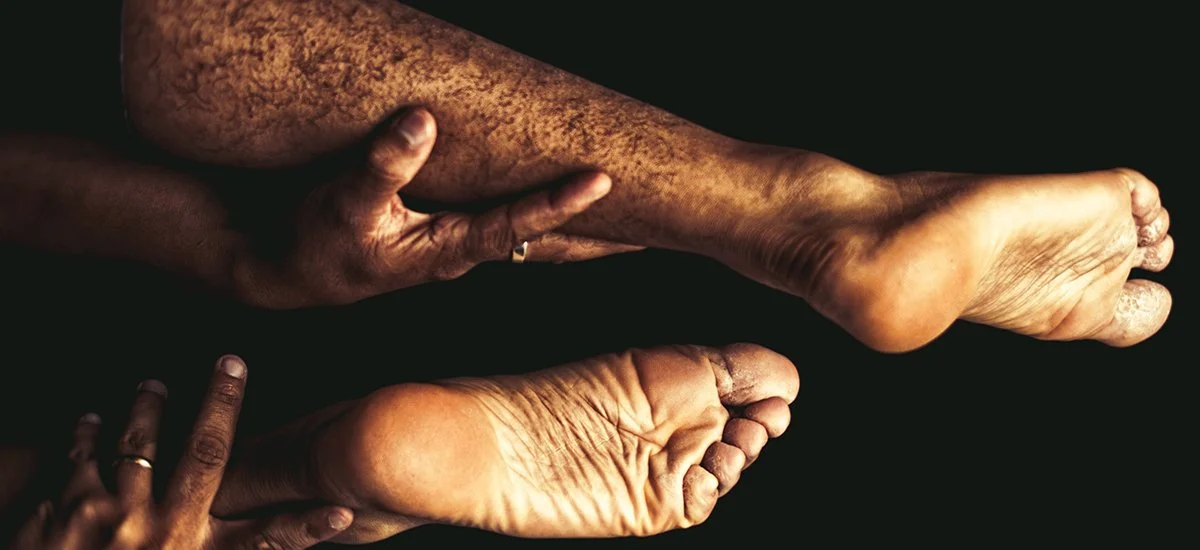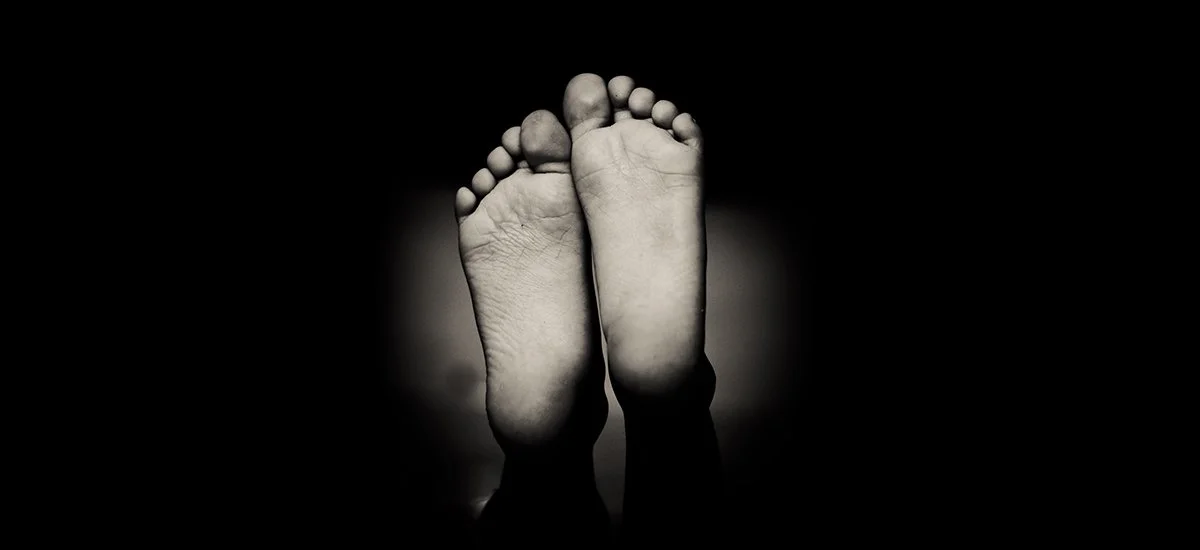Our Fabulous Feet
Take a moment. Be aware of your feet. Maybe this insight might resonate: our feet are truly fabulous. Whatever their size, whatever their condition: our feet are truly fabulous. Really quite small in comparison to our body, yet our feet literally walk us through life (if we are fortunate enough to walk). The feet are our body’s platform.
Each foot has – on average – 26 bones; so about a quarter of the body’s entire bones are in the feet. Each foot has – on average – 33 joints plus many points that are used in acupuncture and reflexology. The feet are also one of the most vascularised areas in the body with numerous blood vessels. As these feet are the furthest area from the heart, poor circulation can be more likely – thus the necessity to be moving legs and feet (like walking).
According to Renaissance artist and innovator Leonardo da Vinci: “The human foot is a masterpiece of engineering and a work of art.” A fair judgment of an often overlooked part of our being. The anatomy of feet mean that their structure is as complex as our hands and the feet have the potential to do many of the movements that we have in our hands.
An implicit message from most shoe manufacturers is that we should not trust evolution and that our feet require rigid supporting structures. As someone said to me: “Nike has a lot to answer for.” Many shoes are almost like castles that are constructed around the intricate anatomy of our feet. These fortresses do both protect and prettify. However, often these restrictive constructions can also squeeze and compress, thus being a cause of significant discomfort. Huge platform shoes, Barbie and the patriarchy also have a lot to answer for.
It is likely that having more minimalist structures (such as what are sometimes called ‘barefoot shoes’ or ‘natural walking shoes’) is better for the overall health of our feet (and thus our knees, our hips, our back, our entire body). There are also the shoes that mimic the heel-to-toe roll of walking (originally MBT (Masai Barefoot Technology) then FitFlops and multiple versions thereof). Taking good care of our foundations and being aware of functionality (like our ability to walk) is infinitely more important than fashion. Katy Bowman wrote in her excellent Simple Steps to Foot Pain Relief: “Footwear is responsible for a host of problems that directly contribute to foot pain and tissue degeneration.” She suggests that perhaps one day wearing high heels will be regarded in the same way as smoking cigarettes.
There are many common expressions that emphasise the importance of feet: “standing on our own two feet”; “getting back on our feet”; “walking our talk”; “putting one foot in front of the other”. Emphasising the importance of both mobility and stability, of both strength and sensitivity. There are thousands and thousands of nerves in each foot. To talk about the neuroscience of feet might sound strange. However, there is sense behind this talk. One example: walking barefoot can improve our proprioception (how we perceive our bodies in space). Norman Doidge (author of the The Brain That Changes Itself) stated: “If we went barefoot, our brains would receive many different kinds of input as we went over uneven surface.”
The ways we walk and how we align our bodies has a considerable influence on our feet. Ideally, according to Bowman, the weight of hips is more over heels as the heel is designed for bearing more weight. Ideally, for most people when standing and walking, the outside edges of feet are reasonably parallel (so there is a slight turning in of the feet). Each of us have significant skeletal variations which definitely impacts on how we align our feet. And each of us have experienced cultural and social influences that also impact on how we align our feet. Finding a healthy and sustainable balance between these different influences is essential – as is acknowledging the inevitability of change (such as what used to work might not work so well now).
Each part of each foot has much importance: all parts are working together as a team. For example, our big toes help us to balance: when we walk, about 50% of our weight goes through this big toe area. Looking after our feet is essential for our health. It is suggested that feet are one of the first areas of the body to became tighter and more restricted with the process of ageing. The adverse consequences of lessening mobility and increasing discomfort in our feet are substantial. As we get older, it becomes more important to take good care of our feet. Getting connected to our feet and working on/waking up our feet are important practices.
When we stretch and strengthen our feet and ankles during yoga and fitness exercises, often we keep them straight and aligned. For the feet and ankles to be strong and resilient, it is better to move them in all possible different angles and positions. It is helpful to strengthen the calves (with knees going from flexed to extended). This could increase the range of ankle dorsiflexion (bringing the toes towards the shins) which can improve our ability to walk.
In the past, I have experienced plantar fasciitis, an inflammation of tissue that causes at times intense discomfort. From these experiences, I have learnt the need to look after my feet. Here are some suggestions that hopefully will help. With all these suggestions, do-able is better than trying to do too much, frequency better than occasional.
• Wear shoes that give your feet space. Make sure that the shoes you are wearing are not too tight (now I wear 10; for many years, I wore 9).
• Go barefoot as much as possible (especially over uneven ground); you can also roll a tennis ball (or something similar) below your feet.
• Massage your feet.
• Soak your feet in a bowl of warm water with grated ginger.
• Have a pedicure; a friend wrote: “it really is an act of self-care for the feet, and they always pamper and massage them.”
• Be careful about not putting too much pressure on inflamed/irritated tissue. Sometimes, we just need to rest.
• Explore lifting and lowering toes independently. Very likely this will be much easier with your big toes. However, over time it can happen with the other toes (and you can use your hands to help).
• Exercise your foot arches by placing the top of toes of one foot on the floor (so foot extension) while other foot is flat on floor. You can do this either sitting or standing.
• Spread your toes. You can do this with your fingers in-between the toes either with the palm on top of the foot or the palm on the sole of the foot. Or you can use a toe spreader.
• Roll your ankles in all directions.
• Holding just above the ankle, shake each foot vigorously.
• Stand on a shakti mat (this has small pins that press into the sole of feet) — a good practice of extending the window of tolerance!
• Stretch the back of lower legs by raising toes and pressing heels downward. You could stand with your toes on a yoga block or a book or something similar and the heels off the block/book. Or you can stand on a step with the heels dropping off a step.
• Squat exercises.
• A lunge (one foot forward; for the foot behind, keep heel on ground). This can also be done by placing a rolled-up towel or mat below the balls of one foot and stepping the other foot forwards (keeping that foot flat on floor); as best as possible, keep hips over back ankle.
• Place feet flat against wall with buttocks either on lift or flat on floor. Then fold forwards while pressing feet firmly into the wall. This can also be done by folding forwards and taking hands over top of feet and drawing them towards you.
• Roll a bottle of frozen water under the soles of feet. This can be particularly useful for plantar fasciitis.
• Jump up and down (again preferably in bare feet) as long as this does not feel too much.
There are many other exercises specifically for feet; these are a good start.
My thanks to the following for advice and ideas: Alan Hirons, Andrew McGonigle, Emma Charlton, Maitripushpa Bois, Melanie Cooper and Rachel David.
A recommended book: Simple Steps to Foot Pain Relief by Katy Bowman (2016: BonBella Books).






